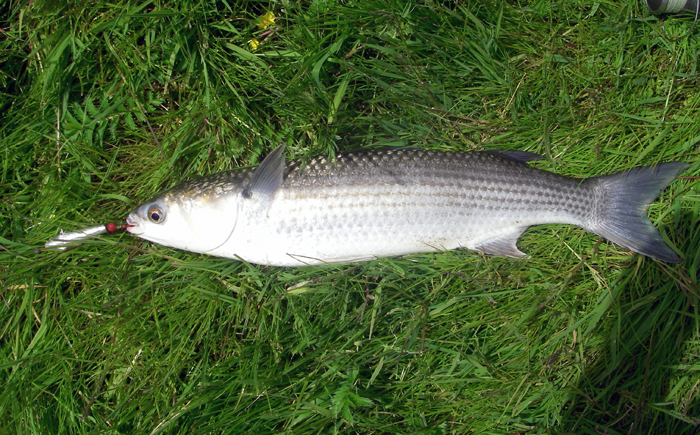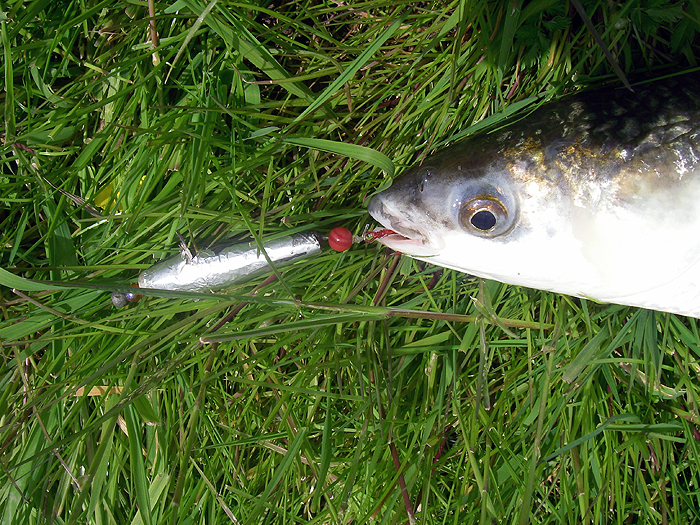

Catch Fish with
Mike Ladle
Information Page
Freshwater Fishing
For anyone unfamiliar with the site always check the FRESHWATER, SALTWATER and TACK-TICS pages. The Saltwater page now extends back as a record of over several years of (mostly) sea fishing and may be a useful guide as to when to fish. The Freshwater stuff is also up to date now. I keep adding to both. These pages are effectively my diary and the latest will usually be about fishing in the previous day or two. As you see I also add the odd piece from my friends and correspondents if I've not been doing much. The Tactics pages which are chiefly 'how I do it' plus a bit of science are also updated regularly and (I think) worth a read (the earlier ones are mostly tackle and 'how to do it' stuff).
(partial) Success!
Followers of my freshwater pages will have noticed that I have recently had a couple of attempts to catch thinlipped mullet from my local river by using a baited Devon minnows. I'd even got as near as having a fish tweak the hook without being impaled. I should say that, in years gone by, I've caught a great many thinlips by spinning with modified Mepps type spoons or Spinnerbaits. All of these catches were made either in the open sea or, much more often, in the salty water of estuaries. Some details of the whys and wherefores of spinning for these fish are given in my tackle and tactics page 127. However, although I know that thinlips swim upstream well into freshwater I've never spent much time trying to catch them in such places. In the salty water I generally use a spinner with a piece of ragworm trailing on a couple of small hooks behind it. Experience has shown that it doesn't matter too much whether the worm is 1cm or 10cm behind the spinning blade, the mullet chase after the lure nd suck at the bait until they are hooked.
The mullet in my local river are a rather different proposition. They have swum up from the sea to feed on the diatom slime which clothes every pebble, weed strand and submerged clay bank. Often they can be seen grazing in small 'herds' on the surface of flint pebbles in quite fast flowing water. It seems to me (possibly wrongly) that a fast spinning spoon will not stay in position long enough to 'get them going' and allow them to take it. Anyway, rightly or wrongly I decided that by legering a wooden Devon held stationary in the current the fish might be induced to nip at a baited hook on its tail end. My first real attempt was dogged by murky water and gloomy skies so I could barely see the fish. As I said I managed to induce a few tentative plucks but hooked nothing.
This brings me to my latest attempt. I bought a quid's worth of ragworms from my local shop (not many but ample for my purpose) and set off for the river. After my previous failure I'd reduced the size of the treble and the single hooks to size 8 and shortened up the rig, reasoning that the fish might hook themselves more readily on the smaller hooks tight to the lure.
When I arrived at the river the water was gin clear and the sun was shining. Perfect! I thought. I soon found the mullet guzzling away at the river bed like so many aquatic sheep. I attached a half ounce weight on a dropper and baited the hooks with a section of worm (see previous freshwater page). I swung it out and allowed the lead to settle just upstream of the feeding fish. Immediately one or two mullet gathered behind the spinning, flashing lure and began to 'nuzzle' at its tail end. However, the bad news was that none of them took the baited hook into their mouths. Clearly the 'scent' of the fresh bait was part of the attraction because after a few minutes they became less interested. Their enthusiasm was rekindled by putting on a new section of worm. Simply letting the minnow spin in the current was fine but I noticed that the fish often became even more interested when I allowed the lure to swing across for a metre or so. This led me to see whether added movement might result in more positive bites. Eventually I found that by vibrating the rod to make the spinning minnow jiggle about seemed to get the mullet really excited but even after dozens of nudges and taps I was fishless.
Although it had clouded over a bit by now the water was so shallow and clear that I could see every 'attack' in detail and I watched carefully to try and suss out why I wasn't hooking any fish. It appeared that they were even touching the back end of the minnow with their lips while the bait and hooks remained outside the mouth. Almost a physical impossibility I thought. My next step was to remove the trailing single hook and prog a tiny section of worm on each point of the treble. Even with this modification the fish managed to avoid being hooked although, eventually, one of the larger mullet (by no means the biggest) did take a 'moved', 'jiggled', lure and was firmly hooked. It fought like stink even on my spinning gear and it was a good five minutes before it registered just over 2kg (4.5lb) on my balance. I took a couple of pictures before returning the fish to the water and realised that I'd been at it for nearly three hours. Enough was enough!
Clearly, despite having caught a good fish I haven't yet solved the problem. The answer must lie in the way the hooks are rigged. I wonder whether using a longer length of nylon and putting the bait 5 or 10cm behind the minnow might work? How effective might the set up be in more usual estuarine conditions? There's always something to think about in mullet fishing.
If you have any comments or questions about fish, methods, tactics or 'what have you!' get in touch with me by sending an E-MAIL to - docladle@hotmail.com
Got one!

Well hooked.

Satisfaction.
